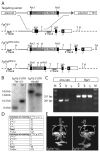Fgf16(IRESCre) mice: a tool to inactivate genes expressed in inner ear cristae and spiral prominence epithelium
- PMID: 18773497
- PMCID: PMC2692467
- DOI: 10.1002/dvdy.21681
Fgf16(IRESCre) mice: a tool to inactivate genes expressed in inner ear cristae and spiral prominence epithelium
Abstract
Fibroblast growth factors play important roles in inner ear development. Previous studies showed that mouse Fgf16 is expressed asymmetrically during the otic cup and vesicle stages of development, suggesting roles in regulating or responding to anteroposterior axial cues. Here, we studied otic Fgf16 expression throughout embryonic development and found transcripts in the developing cristae and in a few cells in the lateral wall of the cochlear duct. To determine the otic function of Fgf16 and to follow the fate of Fgf16-expressing cells, we generated an Fgf16(IRESCre) allele. We show that Fgf16 does not have a unique role in inner ear development and that the Fgf16 lineage is found throughout the three cristae, in portions of the semicircular canal ducts, and in the cochlear spiral prominence epithelial cells. This strain will be useful for gene ablations in these tissues.
Figures



References
-
- Arenkiel BR, Gaufo GO, Capecchi MR. Hoxb1 neural crest preferentially form glia of the PNS. Dev Dyn. 2003;227:379–386. - PubMed
-
- Bok J, Chang W, Wu DK. Patterning and morphogenesis of the vertebrate inner ear. Int J Dev Biol. 2007;51:521–533. - PubMed
-
- Brigande JV, Iten LE, Fekete DM. A fate map of chick otic cup closure reveals lineage boundaries in the dorsal otocyst. Dev Biol. 2000;227:256–270. - PubMed
-
- Chang W, Brigande JV, Fekete DM, Wu DK. The development of semicircular canals in the inner ear: role of FGFs in sensory cristae. Development. 2004;131:4201–4211. - PubMed
Publication types
MeSH terms
Substances
Grants and funding
LinkOut - more resources
Full Text Sources
Molecular Biology Databases

